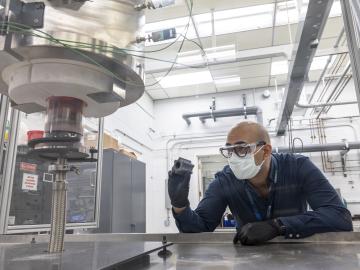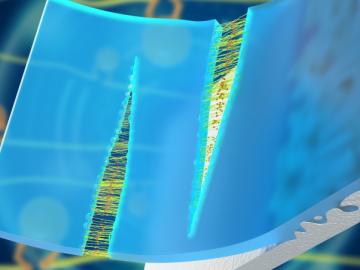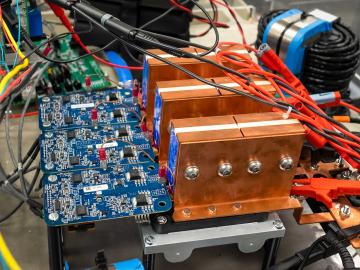
Filter News
Area of Research
- Advanced Manufacturing (2)
- Biology and Environment (11)
- Computer Science (1)
- Energy Science (28)
- Fuel Cycle Science and Technology (1)
- Fusion and Fission (10)
- Fusion Energy (1)
- Isotope Development and Production (1)
- Isotopes (2)
- Materials (21)
- Materials for Computing (5)
- National Security (11)
- Neutron Science (4)
- Nuclear Science and Technology (7)
- Sensors and Controls (1)
- Supercomputing (18)
News Type
News Topics
- (-) Advanced Reactors (12)
- (-) Artificial Intelligence (35)
- (-) Composites (12)
- (-) Grid (16)
- (-) Machine Learning (13)
- (-) Nuclear Energy (28)
- (-) Partnerships (31)
- (-) Polymers (13)
- (-) Security (12)
- (-) Space Exploration (3)
- 3-D Printing/Advanced Manufacturing (48)
- Big Data (8)
- Bioenergy (25)
- Biology (26)
- Biomedical (17)
- Biotechnology (10)
- Buildings (15)
- Chemical Sciences (35)
- Clean Water (2)
- Computer Science (63)
- Coronavirus (17)
- Critical Materials (11)
- Cybersecurity (17)
- Education (3)
- Element Discovery (1)
- Energy Storage (43)
- Environment (38)
- Exascale Computing (13)
- Fossil Energy (1)
- Frontier (16)
- Fusion (17)
- High-Performance Computing (32)
- Isotopes (20)
- ITER (2)
- Materials (60)
- Materials Science (56)
- Mercury (2)
- Microelectronics (1)
- Microscopy (17)
- Molten Salt (3)
- Nanotechnology (29)
- National Security (18)
- Neutron Science (54)
- Physics (26)
- Quantum Computing (13)
- Quantum Science (31)
- Simulation (10)
- Statistics (1)
- Summit (22)
- Transportation (26)
Media Contacts

A new fusion record was announced February 9 in the United Kingdom: At the Joint European Torus, or JET, the team documented the generation of 59 megajoules of sustained fusion energy, more than doubling the

ORNL, TVA and TNECD were recognized by the Federal Laboratory Consortium for their impactful partnership that resulted in a record $2.3 billion investment by Ultium Cells, a General Motors and LG Energy Solution joint venture, to build a battery cell manufacturing plant in Spring Hill, Tennessee.

More than 50 current employees and recent retirees from ORNL received Department of Energy Secretary’s Honor Awards from Secretary Jennifer Granholm in January as part of project teams spanning the national laboratory system. The annual awards recognized 21 teams and three individuals for service and contributions to DOE’s mission and to the benefit of the nation.

Researchers at ORNL used polymer chemistry to transform a common household plastic into a reusable adhesive with a rare combination of strength and ductility, making it one of the toughest materials ever reported.

A novel method to 3D print components for nuclear reactors, developed by the Department of Energy’s Oak Ridge National Laboratory, has been licensed by Ultra Safe Nuclear Corporation.

Ten scientists from the Department of Energy’s Oak Ridge National Laboratory are among the world’s most highly cited researchers, according to a bibliometric analysis conducted by the scientific publication analytics firm Clarivate.

Researchers at ORNL designed a novel polymer to bind and strengthen silica sand for binder jet additive manufacturing, a 3D-printing method used by industries for prototyping and part production.

Research teams from the Department of Energy’s Oak Ridge National Laboratory and their technologies have received seven 2021 R&D 100 Awards, plus special recognition for a COVID-19-related project.

Pengfei Cao, a polymer chemist at ORNL, has been chosen to receive a 2021 Young Investigator Award from the Polymeric Materials: Science and Engineering Division of the American Chemical Society, or ACS PMSE.

ORNL has licensed its wireless charging technology for electric vehicles to Brooklyn-based HEVO. The system provides the world’s highest power levels in the smallest package and could one day enable electric vehicles to be charged as they are driven at highway speeds.


